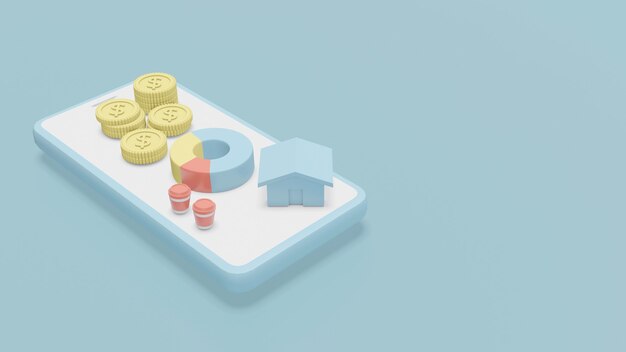Emergency Fund Calculator: Is Your 3-6 Month Savings Enough?

Determining if your personal emergency fund is enough involves calculating your essential monthly expenses and multiplying that figure by three to six months, ensuring you have sufficient savings to cover unexpected job loss, medical bills, or other financial emergencies.
Are you prepared for the unexpected? Many people wonder, “Is Your Personal Emergency Fund Enough? Calculate Your Needs and Secure 3-6 Months of Expenses.” Let’s explore how to calculate your emergency fund, ensuring you’re financially secure for life’s uncertainties.
Understanding the Importance of an Emergency Fund
An emergency fund is more than just a savings account; it’s a financial safety net. It provides a buffer against unexpected expenses, such as medical bills, job loss, or car repairs. Without an emergency fund, you might have to rely on credit cards or loans, which can lead to debt.
Having an emergency fund reduces stress and provides financial stability, allowing you to handle unforeseen circumstances without derailing your financial goals. It’s a cornerstone of sound financial planning.
Why You Need an Emergency Fund
Life is unpredictable, and emergencies can happen to anyone. Here’s why having an emergency fund is crucial:
- Job Loss: Provides a financial cushion while you search for new employment.
- Medical Bills: Covers unexpected medical expenses.
- Car Repairs: Pays for necessary vehicle repairs to keep you mobile.
- Home Repairs: Addresses urgent home maintenance issues.
Common Misconceptions About Emergency Funds
Many people underestimate the importance of an emergency fund or believe they don’t need one. Some common misconceptions include:
- “I have insurance, so I don’t need an emergency fund”: Insurance may not cover all expenses, and deductibles can be high.
- “I can always use my credit card”: Credit cards can lead to high-interest debt.
- “I’m young and healthy, so I don’t need one yet”: Emergencies can happen at any age.
In conclusion, an emergency fund is essential for financial security, providing a buffer against life’s unexpected events and reducing reliance on debt.

Calculating Your Essential Monthly Expenses
The first step in determining the size of your emergency fund is to calculate your essential monthly expenses. This includes the costs you absolutely need to cover to maintain your basic standard of living. Identifying these expenses accurately is paramount.
By knowing your essential expenses, you can determine how much money you’ll need to cover for 3-6 months in case of an emergency. This provides a clear target for your savings goal.
Breaking Down Essential Expenses
Essential expenses are those necessary for your survival and well-being. Here’s a breakdown of common categories:
- Housing: Rent or mortgage payments
- Utilities: Electricity, water, gas, and internet
- Food: Groceries and basic household supplies
- Transportation: Car payments, insurance, gas, or public transportation costs
Using Budgeting Tools to Track Expenses
Tracking your expenses can be overwhelming, but thankfully, numerous tools can help. Budgeting apps, spreadsheets, and online calculators can simplify the process. Some popular tools include:
- Mint: A free budgeting app that tracks your spending.
- YNAB (You Need A Budget): A budgeting software that helps you allocate every dollar.
- Personal Capital: A financial management tool that tracks your net worth and investments.
In summary, determining your essential monthly expenses is the foundation for calculating your emergency fund. Utilizing budgeting tools can streamline this process, providing a clear picture of your financial needs.
Determining the Ideal Emergency Fund Size: 3-6 Months
Once you know your monthly expenses, the next step is determining how many months of expenses your emergency fund should cover. A general rule of thumb is to aim for 3-6 months’ worth. However, the ideal size depends on your individual circumstances and risk tolerance.
Understanding the factors that influence the recommended fund size will help you make an informed decision. Consider your job stability, income sources, and personal financial situation.
Factors Influencing Fund Size
Several factors should influence your decision on whether to save 3, 4, 5, or 6 months’ worth of expenses:
- Job Stability: If you work in a stable industry and have high job security, 3 months might be sufficient.
- Income Sources: If you have multiple income sources, such as a side business, you might need less.
- Health: If you have chronic health issues or a family history of medical problems, a larger fund is recommended.
Adjusting Based on Personal Circumstances
Consider these scenarios to help you decide on the ideal fund size:
- Freelancers: Aim for 6 months or more due to fluctuating income.
- Dual-Income Households: 3-4 months might be sufficient, as both partners contribute.
- High-Risk Industries: 6 months is advisable due to the potential for layoffs.
In summary, the ideal emergency fund size depends on your unique circumstances. Evaluate your job stability, income sources, and personal risk tolerance to determine the right amount for you.

Where to Keep Your Emergency Fund
Choosing the right place to store your emergency fund is crucial. You want it to be accessible when needed but also safe from market fluctuations. High-yield savings accounts, money market accounts, and certificates of deposit (CDs) are good options.
Consider the accessibility, interest rates, and security of each option to make the best choice for your needs. Balancing liquidity and growth is the key here.
High-Yield Savings Accounts
High-yield savings accounts offer a combination of accessibility and competitive interest rates. They are ideal for short-term savings goals and provide easy access to your funds.
- Pros: Accessible, FDIC-insured, and higher interest rates than traditional savings accounts.
- Cons: Interest rates may not keep pace with inflation.
Certificates of Deposit (CDs)
Certificates of deposit (CDs) offer fixed interest rates for a specific term. They are a safe and predictable option, but your money is locked up for the duration of the term.
- Pros: Fixed interest rate, safe investment, and FDIC-insured.
- Cons: Funds are locked up, and early withdrawal penalties apply.
Money Market Accounts
Money market accounts offer a blend of savings and checking features. They typically offer higher interest rates than savings accounts with limited check-writing abilities.
- Pros: Higher interest rates, limited check-writing, and FDIC-insured.
- Cons: Minimum balance requirements and potential fees.
In conclusion, where you keep your emergency fund should depend on your comfort level with accessibility and interest rates. High-yield savings accounts, CDs, and money market accounts each offer unique benefits.
Strategies for Building Your Emergency Fund
Building an emergency fund can seem daunting, but it’s achievable with a strategic approach. Start by setting a realistic goal, creating a budget, and automating your savings. Small, consistent contributions can make a big difference over time.
Stay disciplined and prioritize your emergency fund. With dedication, you can build a solid financial foundation to weather any storm.
Setting a Realistic Savings Goal
Start by breaking down your savings goal into smaller, more manageable milestones. This makes the process less intimidating and provides a sense of accomplishment as you progress.
- Calculate your total goal: Determine your monthly expenses and multiply by 3-6 months.
- Set monthly targets: Divide your total goal by the number of months you want to achieve it in.
Automating Your Savings
Automating your savings ensures that a portion of your income is consistently set aside for your emergency fund. Set up automatic transfers from your checking account to your savings account on a regular basis.
- Set up automatic transfers: Schedule regular transfers to your savings account.
- Treat it like a bill: Make saving a non-negotiable part of your budget.
Cutting Non-Essential Expenses
Identify areas where you can cut back on spending to free up more money for your emergency fund. Evaluate your discretionary spending and prioritize your savings goals.
- Identify non-essential expenses: Review your spending habits and cut unnecessary costs.
- Allocate savings: Direct those savings towards your emergency fund.
In summary, building your emergency fund requires a strategic approach, including setting realistic goals, automating savings, and cutting non-essential expenses. Consistency and discipline are key to success.
Maintaining and Replenishing Your Emergency Fund
Once your emergency fund is established, it’s essential to maintain and replenish it regularly. Unexpected events will inevitably occur, and funds will need to be withdrawn. Make it a priority to replenish these funds as soon as possible.
Regularly reviewing and adjusting your fund ensures that it remains adequate for your needs. Staying proactive helps maintain your financial stability.
Regularly Reviewing Your Fund
Review your emergency fund at least once a year to ensure it still meets your needs. Assess any changes in your monthly expenses, job stability, and overall financial situation.
- Adjust for inflation: Increase your fund to account for rising costs.
- Consider life changes: Adjust for changes in income, family size, or health status.
Replenishing After Use
When you tap into your emergency fund, make it a priority to replenish it as quickly as possible. Treat it as a debt you owe to yourself and set a plan to pay it back.
- Cut back on spending: Temporarily reduce non-essential expenses.
- Increase income: Consider a side hustle or overtime to boost your income.
Avoiding the Temptation to Use It for Non-Emergencies
It’s crucial to resist the temptation to use your emergency fund for non-essential purposes. Differentiate between needs and wants and only use your fund for true emergencies.
- Define emergencies: Clearly define what constitutes an emergency.
- Stick to your plan: Avoid dipping into your fund for frivolous purchases.
In conclusion, maintaining and replenishing your emergency fund is crucial for long-term financial security. Regularly review your fund, replenish it after use, and avoid the temptation to use it for non-emergencies.
| Key Aspect | Brief Description |
|---|---|
| 💰 Importance of Emergency Fund | Provides financial security during unexpected events. |
| 📊 Calculating Essential Expenses | Includes housing, utilities, food, and transportation costs. |
| 🎯 Ideal Fund Size | Aim for 3-6 months of essential living expenses. |
| 🏦 Where to Keep It | High-yield savings accounts are a great option. |
Frequently Asked Questions (FAQs)
Focus on paying off high-interest debt first, then start saving a small amount each month for your emergency fund. Even $25 a month can make a difference!
Evaluate if it’s truly an emergency. If it’s not urgent, consider alternatives. If you must use it, make a plan to replenish it as soon as possible.
Yes, the main risk is missing out on potential investment gains. Excess cash could be invested for better returns while still maintaining a sufficient emergency fund.
A credit card should not be your primary emergency fund. It’s better to have cash savings to avoid accumulating high-interest debt. Use credit cards as a last resort.
Contribute to your emergency fund regularly, ideally every month. Automate your savings to make it consistent and effortless. Even small, consistent contributions add up over time.
Conclusion
In conclusion, determining if your personal emergency fund is enough involves assessing your financial needs, calculating your essential expenses, and implementing strategies to build and maintain your savings. By taking these steps, you can secure financial peace of mind and weather any unexpected storms with confidence.





